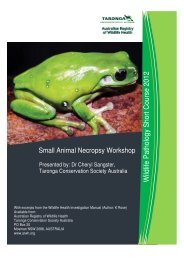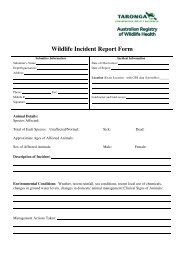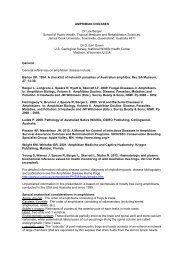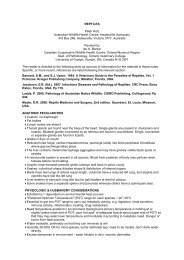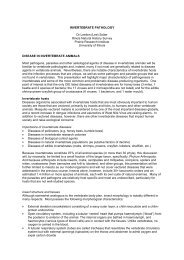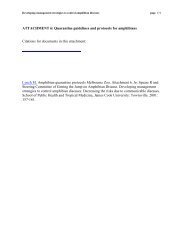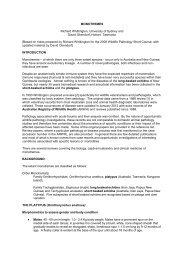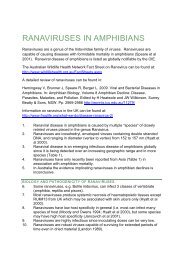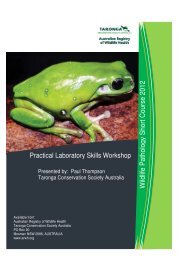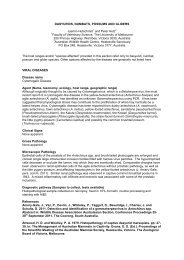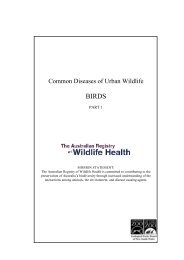MEGABACTERIOSIS IN A ZEBRA FINCH (Poephila guttata) (CASE ...
MEGABACTERIOSIS IN A ZEBRA FINCH (Poephila guttata) (CASE ...
MEGABACTERIOSIS IN A ZEBRA FINCH (Poephila guttata) (CASE ...
You also want an ePaper? Increase the reach of your titles
YUMPU automatically turns print PDFs into web optimized ePapers that Google loves.
<strong>MEGABACTERIOSIS</strong> <strong>IN</strong> A <strong>ZEBRA</strong> F<strong>IN</strong>CH (<strong>Poephila</strong> <strong>guttata</strong>) (<strong>CASE</strong> 1168.1)<strong>CASE</strong> HISTORYFemale adult zebra finch (<strong>Poephila</strong> <strong>guttata</strong>) found dead onthe ground. Had been noted to be lethargic the day before.GROSS PATHOLOGYExternal findings: Small numbers of lice are scatteredthroughout the plumage.Hydration: good, Muscle mass: good, Fat deposits: goodInternal findings: No significant findings.HISTOPATHOLOGYLesions are not evident within the following tissues:oesophagus, brain, myocardium, skeletal muscle, smallintestine, pancreas, ovary, kidneyLung: The pulmonary parenchyma is markedly congested.Small dust granulomas are scattered throughout the atrialinterstitium.Fig 2 Proventriculus H&E 40xFig 4. Ventriculus (gizzard), mucosa and koilin lining. H&E40xFig 1. Lung, dust granulomas. H&ELiver: The hepatic parenchyma is segmentally autolytic.Single cell necrosis of hepatocytes has produced a 'motheaten"appearance to the tissue.Fig 3 Proventriculus H&E 100xFig 5. Ventriculus, mucosa and koilin lining. H&E 100xCase interpretation: Karrie Rose. Photography and case construction: Damien Higgins
Task 1. Describe the sections provided. What is thelikely identity of the organism visible in these? Howwould you identify it with more confidence?Proventriculus / Ventriculus: The proventricular glandsare distended with large numbers of large, filamentous,septate organisms. The intestinal lumen also contains manyof these organisms and abundant sloughed epithelial cells.These organisms are also evident within the deep aspect ofthe ventricular crypts along the proventricular/ventricularjunction. The organisms are multifocally evident within thekoilin layer and superficial epithelium throughout theventriculus (Figs 2-5).Megabacteria are often associated with chronic weight lossin psittacines. This bird was in good body condition, thus,the significance of this finding is uncertain. The sloughingof epithelial cells into the proventricular lumen andventricula koilin layer suggests that the infection may haveresulted in increased cell turnover or cell death.REFERENCESFILIPPICH, L. J. HENDRIKZ, J. K. Prevalence ofmegabacteria in budgerigar colonies. Australian VeterinaryJournal. 1998. 76(2): 92-95.CHRISTENSEN, N. H. HUNTER, J. E. B. ALLEY, M. R.Megabacteriosis in a flock of budgerigars. New ZealandVeterinary Journal. 1997. 45(5): 196-198.BAKER, J. R. Megabacteria in diseased and healthybudgerigars. Veterinary Record. 1997. 140(24): 627.a) b)c) d)Fig 6. Staining characteristics of Megabacteria. a) H&E; b)Brown and Brenn’s Gram’s (BB), c) Periodic acid Schiff(PAS), d) Zeihl Neilsen (ZN).MORPHOLOGICAL DIAGNOSISEctoparasitism - liceExtensive proventricular and ventricular megabacteriosisCOMMENTSThe bird was suffering from extensive gastricmegabacteriosis. The diagnosis was confirmed through theapplication of special stains to recut sections of theproventriculus. Megabacteria stain positively with Gram'sand PAS stains (Fig 6).FILIPPICH, L. J. PARKER, M. G. Megabacteria in wildbirds in Australia. Australian Veterinary Practitioner. 1994.24(2): 84.ANDERSON, N. L. Candida/megabacteria proventriculitisin a Lesser Sulphur-crested Cockatoo (Cacatue sulphureasulphurea). Journal of the Association of AvianVeterinarians. 1993. 7(4): 197-201.FILIPPICH, L. J. PERRY, R. A. Drug trials againstmegabacteria in budgerigars (Melopsittacus undulatus).Australian Veterinary Practitioner. 1993. 23(4): 184-189.HUCHZERMEYER, F. W. HENTON, M. M. KEFFEN, R.H. High mortality associated with megabacteriosis ofproventriculus and gizzard in ostrich chicks. VeterinaryRecord. 1993. 133(6): 143-144.FILIPPICH, L. J. O'BOYLE, D. A. WEBB, R. FUERST, J.A. Megabacteria in birds in Australia. Australian VeterinaryPractitioner. 1993. 23(2): 71-72, 74-76.http://www.vet.uga.edu/vpp/CLERK/Son/Case interpretation: Karrie Rose. Photography and case construction: Damien Higgins




